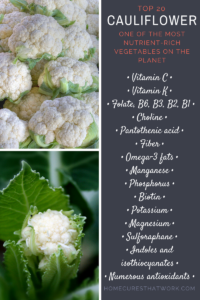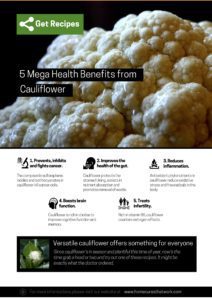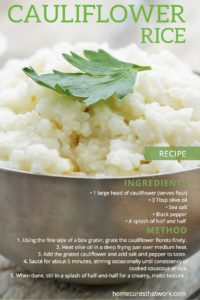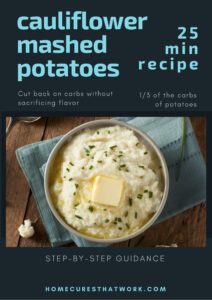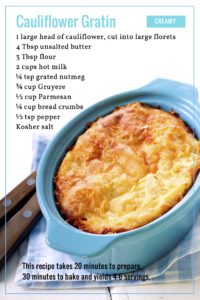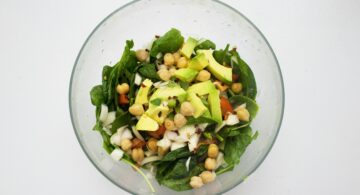Healthy Cauliflower Recipes
3 Surprisingly Creative Recipes for Cauliflower
Thanks to the midnight sun, Scott Robb from Palmer, Alaska, grew the world record cauliflower in 2003 weighing in at an impressive 35.8 pounds! (The average head of cauliflower at the grocer weighs about 2 lbs.) But you don’t need a giant cauliflower to benefit from its colossal inventory of nutrients.
Cauliflower, a member of the brassica family (cruciferous vegetables), is one of the most nutrient-rich vegetables on the planet. In fact, it ranks among the top 20 of the healthiest foods.[1] Just some of cauliflower’s most notable nutrients include:
- Vitamin C
- Vitamin K
- Folate, B6, B3, B2 and B1
- Choline
- Pantothenic acid
- Fiber
- Omega-3 fats
- Manganese
- Phosphorus
- Biotin
- Potassium
- Magnesium
- Sulforaphane
- Indoles and isothiocyanates
- Numerous antioxidants
5 Mega Health Benefits from Cauliflower
Cauliflower with its bland, white appearance may not grace your plate, but it can certainly improve your health. (Actually, you can find cauliflower in more vibrant colors such as: purple, green and orange.) Here’s what cauliflower can do for you.
- Prevents, inhibits and fights cancer. Like other cruciferous vegetables, cauliflower has a slight sulfur smell attributed to the compound sulforaphane. This compound and two others: indoles and isothiocyanates kill cancer cells. In particular, cauliflower has been shown to reduce the risk of prostate, breast, colon, bladder, liver, lung, and stomach cancers.[2]
- Improves the health of the gut. Most people don’t realize that a healthy gut is the key to a strong immune system. Cruciferous vegetables and in particular cauliflower contributes to a healthy digestive system thanks to sulforaphane, glucosinolates, and high fiber content. This combination of compounds protects the stomach lining, assists in detoxification and nutrient absorption, and promotes the removal of waste. They also help inhibit the growth of unwanted bacteria in the intestines.[3]
- Reduces inflammation. Research has revealed that inflammation is the culprit behind almost all chronic diseases today. Heart disease, stroke, diabetes, Alzheimer’s, Parkinson’s and many other diseases result from inflammation. Eliminate inflammation and you greatly reduce your risk of contracting these diseases. Cauliflower boasts a long list of unpronounceable antioxidant phytonutrients that serve to reduce oxidative stress and free-radicals in the body.[4] In other words, eating cauliflower reduces inflammation in the body.
- Boosts brain function. Cauliflower is rich in choline, a B vitamin known for its ability to improve cognitive function and memory. Choline is especially important for pregnant women as this nutrient promotes the baby’s brain development in the womb.[5] Eat a head of cauliflower and benefit your head!
- Treats infertility. You may not have seen this health benefit coming! Pesticides and other pollutants are responsible for an increase in infertility among males. This is due to the fact that these chemicals mimic estrogen, the female sex hormone.[6] Vitamin B6 is often recommended as a natural treatment for infertility as it counters this estrogen effect. Cauliflower stands at the top of the list as the best source for this nutrient. Therefore, men, eat your cauliflower!
I could go on and on about the health benefits of this super-vegetable, but few people will eat something they don’t like. So let’s take a look at some of the delicious ways to prepare this amazing cruciferous vegetable.
Cauliflower Recipes
Raw cauliflower can give you all the benefits of its nutrients without the hassle of cooking. In raw form, cauliflower is great with ranch dressing or other dips. But not everyone enjoys raw cauliflower. As with most vegetables, cooking cauliflower will deplete some of its nutrients. In order to minimize this effect, use as little water as possible and cook it for just a short time.
Fortunately, even though cooking reduces the nutrients available in cauliflower, cooking actually increases our body’s ability to absorb these nutrients.[7] So don’t give up on cooking cauliflower. Some of my favorite ways to cook cauliflower include:
- Grilling – Lightly sprinkle olive oil over quartered florets and season them as desired. Grill over medium heat until they reach the consistency you like. Turn them frequently to avoid burning them.
- Sautéing – Pour a few tablespoons of olive oil or broth (of your choosing) in a frying pan, bring this to medium heat and sauté quartered and seasoned cauliflower florets uncovered until done. You can experiment with a variety of seasonings, or merely use salt and pepper.
- Roasting – Preheat oven to 375 degrees. Cover the bottom of a large cookie sheet with parchment paper. Spread quartered cauliflower florets on the parchment paper and sprinkle with olive oil and seasonings. Roast in the oven for 15 to 20 minutes or until done to your liking.
We’ve found that these three methods of cooking are superior to boiling or steaming in their ability to retain the nutrients. These methods also enhance the flavor of the cauliflower.
Cauliflower is an extremely versatile vegetable in the ways it can be cooked and the purpose for which you use it in a meal. For instance, there are numerous ways to use cauliflower to substitute for a starch or carb with far fewer calories and all the healthy nutrients. Cauliflower rice is one such example.
Cauliflower Rice[8]
Hint: no rice is used in the making of this dish!
Ingredients
- 1 large head of cauliflower (serves four)
- 3 Tbsp olive oil
- Sea salt
- Black pepper
- A splash of half and half
Directions
- Remove base stem and leaves from cauliflower head. Using the fine side of a box grater, grate the cauliflower florets finely. (A food processor tends to shred it instead of grate it.)
- Heat olive oil in a deep frying pan over medium heat.
- Add the grated cauliflower and add salt and pepper to taste. (You can also add turmeric or other seasonings.)
- Sauté for about 5 minutes, stirring occasionally. You want the cauliflower to have the consistency of cooked couscous or rice.
- When done, stir in a splash of half-and-half to give it a creamy, moist texture.
- Serve as a starch, a vegetable, or add cooked meat, sauces or whatever else you might do with rice.
Since cauliflower’s in season and plentiful this time of year, now’s the time grab a head or two and try out one of these recipes. It might be exactly what the doctor ordered. Whether you’re a soup lover, a vegetarian, or a comfort-food fanatic, versatile cauliflower offers something for everyone. It’s hearty enough to command the Thanksgiving table with a delicious recipe like these.
Cauliflower “Mashed Potatoes”[9]
Cauliflower has roughly 1/3 of the carbs of potatoes so this recipe is ideal if you want to cut back on carbs without sacrificing flavor. Total prep and cook time approximately 25 minutes.
Ingredients
- 1 large head of cauliflower, cut into florets
- 1 Tbsp olive oil
- 1 clove garlic, smashed
- ¼ cup grated Parmesan cheese
- 1 Tbsp cream cheese
- ½ tsp kosher salt
- 1/8 tsp freshly ground black pepper
Directions
- Use a steamer insert in a saucepan and fill with water just below the steamer. Bring water to a boil and add cauliflower. Cover and steam until tender, about 10 minutes.
- Meanwhile, heat olive oil in a small skillet over medium heat. Sauté garlic, stirring occasionally until softened (about 2 minutes) and remove from heat.
- Place half the cooked cauliflower to a food processor; cover and blend on high. Add remaining cauliflower florets one at a time until the mixture is creamy. Blend in garlic, Parmesan cheese, cream cheese, salt and black pepper.
Cauliflower Gratin[10]
This recipe takes 20 minutes to prepare and 30 minutes to bake and yields 4-6 servings.
Ingredients
- 1 large head of cauliflower, cut into large florets
- Kosher salt
- 4 Tbsp unsalted butter, divided
- 3 Tbsp all-purpose flour
- 2 cups hot milk
- ½ tsp freshly ground black pepper
- ¼ tsp grated nutmeg
- ¾ cup freshly grated Gruyere, divided
- ½ cup freshly grated Parmesan
- ¼ cup fresh bread crumbs
Directions
- Preheat oven to 375 degrees F.
- Boil cauliflower florets in a large pot of salted water for 5 to 6 minutes until tender but still firm, and drain.
- Meanwhile, melt 2 Tbsp butter in a medium saucepan over low heat. Add the flour, stirring constantly with a wooden spoon for 2 minutes. Then add the hot milk into the butter-flour mixture and stir until it comes to a boil. Boil, whisking constantly for 1 minute or until thickened. Remove from heat and add 1 tsp salt, pepper, nutmeg, ½ cup Gruyere, and the Parmesan.
- Pour 1/3 of the sauce on the bottom of an 8 x 11 x 2 inch baking dish. Place the drained cauliflower on top and spread the rest of the sauce evenly on top. Combine the bread crumbs with the remaining ¼ cup of Gruyere and sprinkle on top. Melt the remaining 2 Tbsp of butter and drizzle over the gratin. Sprinkle with salt and pepper.
- Bake for 25 to 30 minutes until the top is browned. Serve hot or at room temperature.
You can do 101 things with cauliflower and we haven’t even mentioned soups and salads! If you don’t have any trusty cauliflower recipes, then you’re missing out on the powerful benefits of this seemingly bland cruciferous vegetable. Eating cauliflower, which is loaded with disease-fighting nutrients and phytochemicals, may help defend you against life-threatening diseases such as heart disease and cancer.
With all its health benefits, its versatility and great taste why not pick up a nice firm head of cauliflower today and begin experimenting with one of the recipes provided here.



